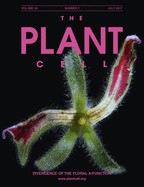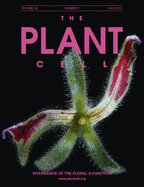
Cover image

Flower development requires accurate patterning of the floral organ identity genes since their misexpression leads to homeotic conversion of one floral organ type into another. The cover image illustrates a subtle defect in the patterning of the homeotic B-class genes in the petunia ben mutant, leading to a partial homeotic conversion of sepals into petals. Morel et al. (pages
Volume 29, Issue 7, July 2017
IN BRIEF
Tracking the Bacterial Type III Secretion System: Visualization of Effector Delivery Using Split Fluorescent Proteins
BEN, ROB, and the Making of a Petunia Flower
Exploring Maize Leaf Architecture from Different Angles
The Who, What, and Where of Plant Polyprenol Biosynthesis Point to Thylakoid Membranes and Photosynthetic Performance
Crossover Guard: MEICA1 Prevents Meiotic Mishaps
BREAKTHROUGH REPORTS
Direct and Indirect Visualization of Bacterial Effector Delivery into Diverse Plant Cell Types during Infection
The GFP strand system enables spatial and temporal visualization of bacterial effector delivery during infection.
Spatiotemporal Monitoring of Pseudomonas syringae Effectors via Type III Secretion Using Split Fluorescent Protein Fragments
Using the split GFP system to monitor type III effectors secreted from bacteria into plant cells.
LARGE-SCALE BIOLOGY ARTICLE
AspWood: High-Spatial-Resolution Transcriptome Profiles Reveal Uncharacterized Modularity of Wood Formation in Populus tremula
The AspWood large-scale data set comprises high-spatial-resolution RNA-seq transcriptome profiles collected across the phloem-cambium-xylem developmental zone of aspen trees.
RESEARCH ARTICLES
Divergence of the Floral A-Function between an Asterid and a Rosid Species
Petunia research suggests that the mechanisms controlling the spatial restriction of floral organ identity genes are more diverse than the well-conserved B and C floral organ identity functions.
Maize YABBY Genes drooping leaf1 and drooping leaf2 Regulate Plant Architecture
Maize drooping leaf genes are necessary for proper leaf development and reside within quantitative trait locus regions for agronomically important leaf architecture traits.
ZHOUPI and KERBEROS Mediate Embryo/Endosperm Separation by Promoting the Formation of an Extracuticular Sheath at the Embryo Surface
A cysteine-rich peptide, KERBEROS, acts downstream of the transcription factor ZHOUPI to modify the embryo-endosperm interface and mediate the separation of these two tissues during seed development.
Homologs of PROTEIN TARGETING TO STARCH Control Starch Granule Initiation in Arabidopsis Leaves
Two plastidial coiled coil-containing proteins play a critical role in delivering suitable maltooligosaccharide primers to STARCH SYNTHASE4 during starch granule initiation.
A Plastid Phosphatidylglycerol Lipase Contributes to the Export of Acyl Groups from Plastids for Seed Oil Biosynthesis
PLIP1, a plastid lipase specific for a unique chloroplast lipid, phosphatidylglycerol tagged with 16:1 trans fatty acid, is involved in acyl exchange and fatty acid export for seed oil biosynthesis.
Meiotic Chromosome Association 1 Interacts with TOP3α and Regulates Meiotic Recombination in Rice
MEICA1 interacts with TOP3α and plays pivotal roles in processing recombination intermediates and limiting meiotic crossover formation during rice meiosis.
Polyprenols Are Synthesized by a Plastidial cis-Prenyltransferase and Influence Photosynthetic Performance
A plastidial cis-prenyltransferase synthesizes a family of polyprenols that accumulate in thylakoid membranes and play a central role in the efficiency of photosynthetic performance.
Suppressors of the Chloroplast Protein Import Mutant tic40 Reveal a Genetic Link between Protein Import and Thylakoid Biogenesis
Genetic analyses identify the chloroplast proteins ALB4 and STIC2 as coactors in a specialized thylakoid protein targeting pathway, and a link between envelope translocation and thylakoid targeting.
A Lipid-Anchored NAC Transcription Factor Is Translocated into the Nucleus and Activates Glyoxalase I Expression during Drought Stress
Under drought stress, lipid-anchored MfNACsa translocates to the nucleus by thioesterase MtAPT1-dependent de-S-palmitoylation, regulating GlyI gene expression and GSH/GSSG ratio.
Arabidopsis ATRX Modulates H3.3 Occupancy and Fine-Tunes Gene Expression
The Alpha Thalassemia-mental Retardation X-linked homolog functions as a H3.3 chaperone and modulates gene expression in Arabidopsis.


